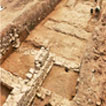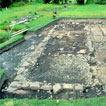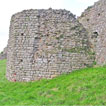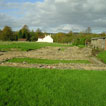Towns
Before the Roman period, there were no towns in our area. However, the presence of troops with pay to spend proved a magnet to traders and other camp-followers, and towns of a kind seem to have started growing up quickly outside the gates of the forts. What happened if the army moved on will have depended upon how deeply-rooted the settlement had become - certainly at places like Chepstow and Abergavenny where the forts were probably given up relatively early, the town seems to have continued in occupation. We do not know very much about most of these settlements. At Neath, one of the best known, some buildings have been excavated along the road leading to the north-east gate of the fort.
The fortress at Caerleon had two settlements, one around the walls, and the other at #Bulmore a couple of miles up the Usk valley on the opposite side of the river. Tombstones found at Bulmore show that some of its inhabitants were retired legionaries and their families, who settled to form a ribbon development along the road to Usk. The attraction of a separate township here may have been that it lay outside the land controlled by the legion, which would have given the occupants more opportunity for self-government. Bulmore was much smaller and less well equipped than the town at Caerleon itself. Excavation and geophysical survey show that the canabae (‘hutments’) outside the walls contained some very impressive public buildings as well as houses and shops.
Ten miles away was Caerwent, which had became the administrative capital for the Silures by the beginning of the 2nd century. Along with shops and houses, the buildings that have been excavated here include the forum and basilica, the civic building where the tribal council met and where the law courts would have been. There was also a temple, standing in a precinct. Massive walls were eventually built around the town, and impressive sections of them still survive. At Cowbridge, the ribbon development along the Cardiff to Neath road may have been a minor administrative centre.





